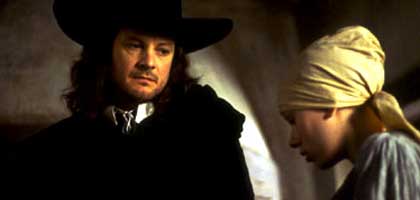
Girl with a Pearl Earring
UK/Luxembourg/USA 2003

Reviewed by David Jays
Synopsis
Our synopses give away the plot in full, including surprise twists.
Delft, 1665. Griet (Scarlett Johansson), whose family has fallen into poverty, is employed as a servant by the Vermeer household. Johannes Vermeer (Colin Firth) is an artist, whose perfectionism limits the number of paintings he can produce to support his family. Griet's duties include cleaning his studio and he notices her feel for painting. Vermeer is commissioned to produce a portrait for his patron Van Ruijven (Tom Wilkinson) and decides to paint Griet wearing one of his wife Catharina's pearl earrings. In addition to her other duties, Griet works through the night to prepare Vermeer's paints.
As the bond between them grows, Catharina (Essie Davis) suspects her husband, while their daughter (Alakina Mann) spitefully attempts to get Griet dismissed. The predatory Van Ruijven assaults Griet, and she is also courted by the butcher boy, Pieter (Cillian Murphy). When Vermeer's wife sees the portrait, she is furious; Griet is dismissed. Vermeer sells the portrait and sends Griet the earrings.
Review
Although the artist Johannes Vermeer has never been held in higher esteem, his personality remains shadowy. His most celebrated paintings capture a moment of suspension, of activity hanging in the balance. Tracy Chevalier's 1999 novel responds to this sense of withheld immediacy by imagining a relationship with a servant girl that might unlock the mysterious atmosphere of the 1665 portrait Girl with a Pearl Earring . Chevalier's success rests on deploying period detail against the slow build of sexual tension, despite unremarkable characterisation and narrative. Peter Webber's debut feature replicates these features, but even if its central relationship is unconvincing, he crafts a compelling film about the work that surrounds art's stilled life.
The movie's view of the past is determinedly unromantic: Delft, the film's rain-slapped setting, is a raw place where pigs' heads are thrown on butchers' trestles and bailiffs hover round bankrupt neighbours. The household too is a place of labour rather than leisure. We see determination in Griet's slender arms, her knuckles scuffed and singed. She sleeps beneath pots in the cellar, alongside the children and a fellow servant. Tensions can't be concealed in this enforced intimacy, and walls and furniture intrude into every shot (echoing Vermeer's own framing devices). In this household of unsmiling moods, Vermeer's indolent wife is puffy with boredom and pregnancy and her eldest daughter is a pint-sized piece of malevolence who spitefully tries to engineer Griet's dismissal.
Griet's duties include cleaning the artist's studio, a charged space announced by a sliver of daylight at the end of a dark corridor. Unlike the rest of the house, it offers space, amplified by the painting's imaginary vistas. It attracts Griet's curiosity - when she stands in front of an easel looking at work in progress, we see her in the clearest light yet. Chevalier introduces Vermeer with a hokey exchange over Griet's colour-coded soup vegetables. The film delays his appearance, establishing the effect of his reclusive temper on the household. But Colin Firth creates a familiar figure of the artist as an unkempt sulk. The actor is brooding, unshaven and, as usual, stingy with his smiles, and Vermeer's attraction to Griet is routinely drawn.
Although the film fudges relationships, it is far more assured at depicting environment and Griet's thoughtful response to it. Scarlett Johansson's marvellous performance builds on the complex innocence of her screen presence ( Ghost World , Lost in Translation ). Her sensibility is established when she instinctively arranges some vegetables into a still life in the opening scene. She alone appreciates Vermeer's paintings, allowing herself a rare smile when he prompts her to look beyond conventional visual descriptions. Against the film's predominantly grey palette, the painter's blue and yellow pigments are thrillingly vivid: Griet holds a piece of gum arabic to the light as if a jewel. The drudgery of her daytime duties is contrasted by rapt work with pestle and mortar, spatula and pipette.
Artistic responsibility is matched by the emotional burden of posing for a portrait upon which the household finances depend. Each stage of the process requires a new intimacy. The painter's thumb smears a tear on her lip, and he finally persuades her to remove her cap, gazing on her auburn ringlets. Immaculate Griet must have her ear pierced for the pearl earring - the sound effect of the piercing and trickle of blood marks the end of innocence.
Griet earlier wonders whether to wash the mucky studio windows and risk losing the precious muffle of dusty light. Webber and DoP Eduardo Serra deftly deploy daylight, candle and shadow, denying our desire to see clearly just as Vermeer refuses to explicate the situations in his paintings. The film's scenarios may be unsurprising, but Webber's solemn evocation of art in a grey world gives his story an apt, unspoken gravity.
Credits
- Director
- Peter Webber
- Producers
- Andy Paterson
- Anand Tucker
- Screenplay
- Olivia Hetreed
- Based on the novel by Tracy Chevalier
- Director of Photography
- Eduardo Serra
- Editor
- Kate Evans
- Production Designer
- Ben van Os
- Music/Music Conductor/Orchestrator
- Alexandre Desplat
